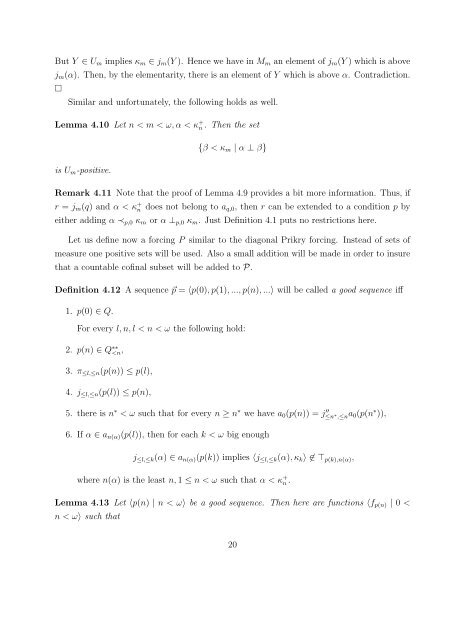On changing cofinality of partially ordered sets
On changing cofinality of partially ordered sets
On changing cofinality of partially ordered sets
You also want an ePaper? Increase the reach of your titles
YUMPU automatically turns print PDFs into web optimized ePapers that Google loves.
But Y ∈ U m implies κ m ∈ j m (Y ). Hence we have in M m an element <strong>of</strong> j m (Y ) which is above<br />
j m (α). Then, by the elementarity, there is an element <strong>of</strong> Y which is above α. Contradiction.<br />
□<br />
Similar and unfortunately, the following holds as well.<br />
Lemma 4.10 Let n < m < ω, α < κ + n . Then the set<br />
is U m -positive.<br />
{β < κ m | α ⊥ β}<br />
Remark 4.11 Note that the pro<strong>of</strong> <strong>of</strong> Lemma 4.9 provides a bit more information. Thus, if<br />
r = j m (q) and α < κ + n does not belong to a q,0 , then r can be extended to a condition p by<br />
either adding α ≺ p,0 κ m or α ⊥ p,0 κ m . Just Definition 4.1 puts no restrictions here.<br />
Let us define now a forcing P similar to the diagonal Prikry forcing. Instead <strong>of</strong> <strong>sets</strong> <strong>of</strong><br />
measure one positive <strong>sets</strong> will be used. Also a small addition will be made in order to insure<br />
that a countable c<strong>of</strong>inal subset will be added to P.<br />
Definition 4.12 A sequence ⃗p = 〈p(0), p(1), ..., p(n), ...〉 will be called a good sequence iff<br />
1. p(0) ∈ Q.<br />
For every l, n, l < n < ω the following hold:<br />
2. p(n) ∈ Q ∗∗<br />
















